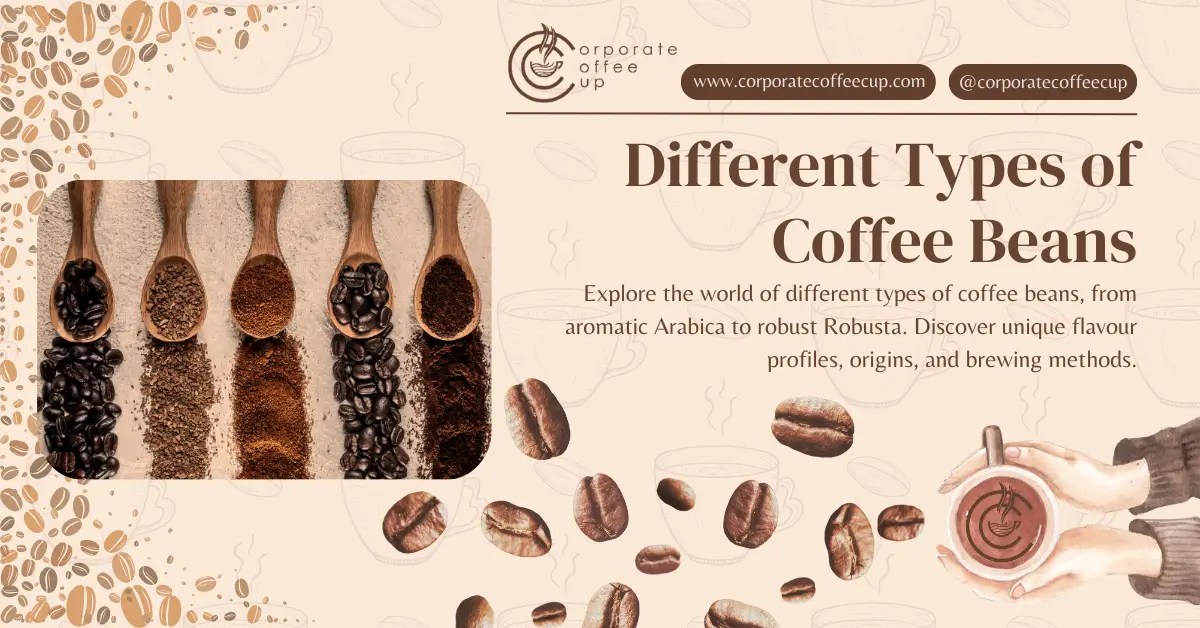Coffee—the aromatic elixir that powers our mornings and punctuates our afternoons. Behind every perfect cup lies the humble coffee bean, yet how many of us truly understand the remarkable differences between varieties? Today’s speciality coffee market offers an unprecedented selection of beans, each with distinctive flavour profiles, growing conditions and characteristics.
This comprehensive guide explores the different types of coffee beans, from the well-known Arabica to the lesser-discussed but equally intriguing Liberica. Whether you’re a casual coffee drinker or an aspiring connoisseur, understanding these differences will transform your coffee experience and help you discover new favourites that perfectly match your palate.
The different types of coffee beans
1. Arabica: The Sophisticated Standard
Arabica beans represent approximately 60% of global coffee production and are widely considered the gold standard for quality coffee. These beans thrive at higher altitudes between 1,000-2,000 metres, preferring cooler temperatures and consistent rainfall.
Key characteristics:
- Sweeter, more complex flavour profile with notes of fruit, berries, chocolate and nuts
- Lower caffeine content (typically 1.2-1.5%)
- Higher acidity, which contributes to brighter flavours
- More delicate growing requirements, make them susceptible to disease and frost
Arabica coffee originated in Ethiopia but now flourishes in regions across Latin America, particularly Colombia and Brazil, as well as parts of Africa. Its popularity stems from its sophisticated flavour profile, though this comes at a cost—both literal and figurative. Arabica plants yield fewer beans and require more precise growing conditions, making them more expensive to produce.
2. Robusta: The Bold Workhorse
Robusta makes up most of the remaining 40% of global coffee production. These hardy plants grow at lower altitudes (200-800 metres) and showcase impressive resistance to disease and pests thanks to their higher caffeine content, which acts as a natural insecticide.
Key characteristics:
- Stronger, more bitter flavour with earthy, woody and sometimes rubbery notes
- Nearly double the caffeine content of Arabica (2.2-2.7%)
- Lower acidity with a heavier body
- Exceptional disease resistance and higher yield
Vietnam leads global Robusta production, followed by Brazil and Indonesia. While often considered inferior to Arabica, high-quality Robusta beans play a crucial role in espresso blends, providing the rich crema and fuller body that espresso enthusiasts prize. They’re also the backbone of instant coffee products worldwide.
3. Liberica: The Rare Delicacy
Liberica beans account for less than 2% of global coffee production. These beans grow on unusually tall trees (up to 17 metres) and produce asymmetrical, larger beans with a distinctive hook at one end.
Key characteristics:
- Unique flavour profile often described as woody, smoky and floral with fruit-forward notes
- Full body with lower acidity
- Irregular bean shape and larger size
- Extremely hardy plants that can withstand harsh conditions
Liberica nearly faced extinction during a coffee leaf rust epidemic in the late 19th century. Today, it’s primarily grown in the Philippines, Malaysia and parts of West Africa. Its scarcity and distinct taste make it a sought-after speciality for adventurous coffee enthusiasts.
4. Excelsa: The Mysterious Outlier
Though technically reclassified as a variety of Liberica in 2006, many coffee experts still consider Excelsa distinct enough to merit its own category. Like Liberica, Excelsa grows on tall trees and represents a tiny fraction of global production.
Key characteristics:
- A complex flavour profile that combines light roast traits (tart, fruity notes) with dark roast characteristics (deep, roasted flavours)
- Medium to high body with good acidity
- Smaller, rounder beans than Liberica
- Similar resilience to harsh growing conditions
Excelsa primarily grows in Southeast Asia, particularly Vietnam and the Philippines. Its unique taste profile makes it valuable for adding complexity to blends, though it rarely appears as a single-origin offering.
A super comparison of the different types of coffee beans
Processing Methods and Their Impact
The way coffee beans are processed after harvesting significantly influences their final flavour profile:
| Processing Method | Characteristics | Flavour Profile | Common Regions |
|---|---|---|---|
| Washed (Wet) | Pulp removed before drying | Clean, bright, higher acidity | Colombia, Kenya, Ethiopia (highlands) |
| Natural (Dry) | Whole cherry dried with bean inside | Fruitier, fuller body, wine-like | Ethiopia, Brazil, Yemen |
| Honey/Pulped Natural | Some mucilage left during drying | Balanced sweetness, medium body | Costa Rica, Brazil, El Salvador |
| Wet-Hulled | Unique Indonesian method | Earthy, spicy, low acidity | Indonesia (Sumatra, Sulawesi) |
Different types of coffee beans and their origin
Like wine, coffee exhibits terroir—the environmental factors that affect different types of coffee beans, their taste and flavour profile. Some notable regional characteristics include:
- Ethiopian beans: Known for bright acidity, floral notes and berry-forward flavours
- Colombian beans: Balanced with medium acidity, caramel sweetness and nutty undertones
- Brazilian beans: Lower acidity, nutty chocolate notes and good body
- Kenyan beans: Bold, and bright with distinctive blackcurrant notes and wine-like acidity
- Indonesian beans: Earthy, spicy, full-bodied with low acidity and sometimes herbaceous notes
Conclusion
The world of the different types of coffee beans offers remarkable diversity, from the widely available Arabica and Robusta to the rare and distinctive Liberica and Excelsa varieties. Each bean type brings unique characteristics to your cup, influenced further by growing region, processing method and roasting approach. By understanding these differences, you can make more informed choices about your coffee purchases and brewing methods.
The next time you sip your morning brew, take a moment to appreciate the extraordinary journey from tropical mountainsides to your cup. Whether you prefer the delicate complexity of a single-origin Ethiopian Arabica or the bold intensity of a Robusta-forward espresso blend, knowing the story behind your beans enhances the entire coffee experience.
Remember that the “best” coffee is ultimately the one that brings you the most enjoyment. Don’t be afraid to experiment with different varieties, origins and processing methods—you might discover flavour profiles you never knew existed. Happy brewing!
FAQs About Coffee Beans
Which coffee bean has the most caffeine?
Robusta contains approximately 2.2-2.7% caffeine content, nearly double that of Arabica (1.2-1.5%). If you’re seeking a morning jolt, Robusta provides significantly more stimulation.
What’s the difference between single-origin and blended coffee?
Single-origin coffee comes from one specific geographic region, sometimes even a single farm or lot. Blends combine beans from multiple origins to achieve consistent flavour profiles. Single-origin coffees showcase unique regional characteristics, while blends offer balanced, consistent experiences.
How should I store coffee beans?
Store beans in an airtight container away from light, heat, moisture and strong odours. Contrary to popular belief, refrigerating coffee beans isn’t recommended as they can absorb moisture and odours. For optimal freshness, purchase smaller quantities more frequently and consume within 2-4 weeks of roasting.
How does roast level affect coffee flavour?
Light roasts preserve origin characteristics with higher acidity and complexity. Medium roasts offer balanced profiles with developed sweetness. Dark roasts feature bolder, more bitter flavours with pronounced roast character and less origin distinctiveness. No single roast level is “best”—it’s entirely subjective based on personal preference.

